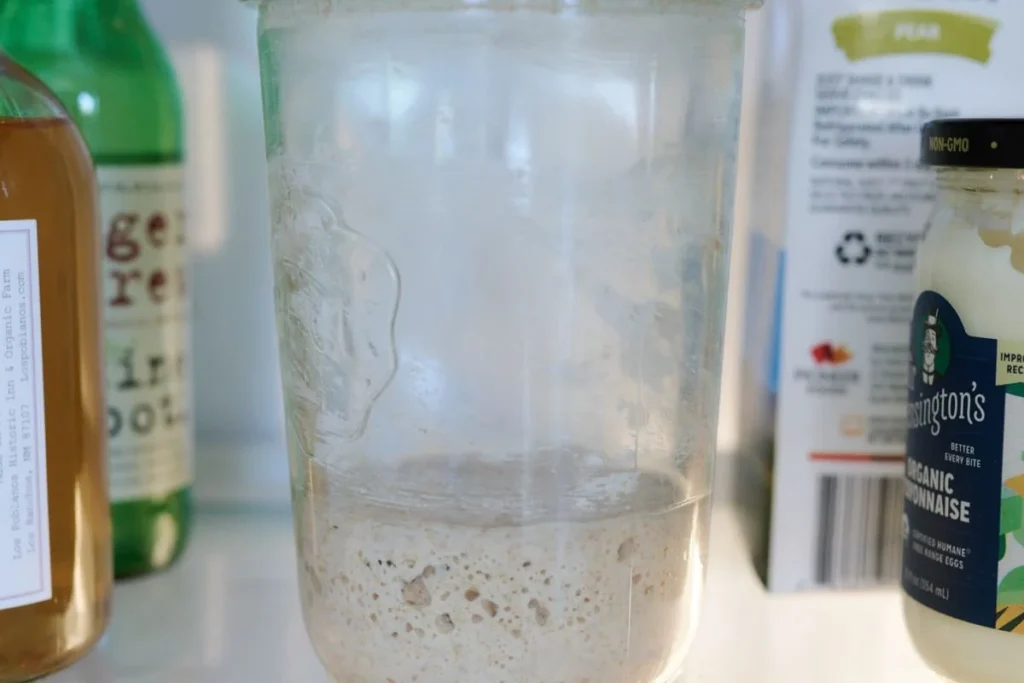
Can You Use Sourdough Starter Straight From the Fridge
Ever thought about pulling your sourdough starter straight from the fridge for some spontaneous baking? The answer is a definite yes, but there’s more to it than you might think.
In this guide, we’ll dig into how to use your chilled starter, exploring the benefits, possible challenges, and the delicious flavors that cold fermentation can add to your homemade sourdough.
Find out how a fridge-stored starter gives you flexibility, understand how the cold nap affects its vitality, and unravel the mysteries of feeding, reactivating, and prolonging the life of your sourdough sidekick.
Whether you’re a seasoned sourdough fan or just starting to explore the world of wild yeast and bacteria, this guide is your ticket to becoming a sourdough pro. Get ready to step up your baking game with the ease and unique flavors that a chilled sourdough starter can bring to your kitchen!
Table of Contents
ToggleHow Keeping Your Sourdough Starter in the Fridge Impacts It
A lot of bakers stash their sourdough starter in the fridge to make their baking schedule more flexible. Knowing how the fridge affects your sourdough starter is key to keeping it healthy and lively.
When your sourdough starter hangs out in the fridge, the cold slows down the fermentation process. This slowdown lets you go longer between feedings, which is handy if you’re busy. But remember, just because it’s chilling doesn’t mean your starter is totally asleep.
The cold fridge keeps the wild yeast and bacteria from growing too fast, keeping your sourdough culture intact. This can be a win for bakers who don’t bake every day or those short on time for daily feedings.
However, the catch is that when you’re ready to use your refrigerated starter, you’ve got to give it time to warm up. Before mixing it into your dough, let it get to room temperature and wake up. This warm-up ensures your starter is lively and all set to join the fermentation party, influencing how your sourdough bread rises, its flavor, and its texture.
As you figure out the ins and outs of keeping your sourdough starter in the fridge, find that sweet spot between convenience and having an energetic, lively culture for the perfect loaf.

Can I Use My Starter Straight From The Fridge?
Ever wondered if you can grab your sourdough starter right out of the fridge? The answer is a big yes, but there are a couple of things to keep in mind. Using your chilled starter can be a game-changer in your baking routine, making it super easy to whip up tasty sourdough treats without the long wait times of the traditional room temperature method.
When you go for a cold starter, it’s important to check how active it is. If it’s been napping, give it some extra time to wake up before adding it to your recipe. To get the best results, let your refrigerated starter warm up to room temperature. This ensures that the yeast and bacteria in it are fully awake and ready to kickstart a strong fermentation process.
The cool thing about using a fridge-stored starter is how flexible it is. Whether you feel like baking on a whim or planning ahead, the chilled approach gives sourdough fans a versatile option. Enjoy the convenience, try out different recipes, and appreciate the unique flavors that cold fermentation can add to your homemade sourdough creations.
So, can you use your sourdough starter straight from the fridge? Absolutely—just give it a little time to wake up before you start your next cooking adventure.
Can You Feed Sourdough Starter Right Out of the Fridge?
Feeding your sourdough starter is a critical step in maintaining its health and ensuring the success of your bakes. However, the question arises: can you feed your sourdough starter directly from the fridge? The answer is a nuanced exploration into the world of sourdough care.
When your sourdough starter has been resting in the fridge, it enters a dormant state. Feeding it immediately after pulling it from the cold environment might not yield the best results. Sourdough starters, like any living organism, benefit from a gradual awakening. Instead of diving straight into feeding, allow your starter to reach room temperature first.
To revive a refrigerated sourdough starter, take it out and let it sit at room temperature for at least a couple of hours. This gives the yeast and bacteria within the starter a chance to wake up and become active. Once it reaches room temperature, you can proceed with the feeding process, refreshing it with flour and water.
By allowing your sourdough starter this warm-up period, you’re setting the stage for a robust and thriving culture.
How To Reactivate Sourdough Starter From the Fridge
So, your sourdough starter has been lounging in the fridge, taking a chilly nap. Now, you’re ready to awaken its dormant magic and get back to the world of artisanal bread-making. Fear not, for reactivating your sourdough starter is a straightforward process that involves a bit of time, and patience.

Step 1: Gather Your Supplies
Before diving into the revival process, ensure you have all your tools at the ready. You’ll need your chilled sourdough starter, all-purpose flour, lukewarm water, a non-metallic bowl, and a clean cloth for covering.
Step 2: Assess the Starter
Take a good look at your sourdough starter. If there’s any discolored liquid on top, commonly known as “hooch,” don’t panic. Pour it off; it’s a natural byproduct of fermentation. Check for any unusual odors; a slightly tangy smell is normal, but foul or moldy scents are red flags.
Step 3: Discard and Measure
Scoop out a portion of your sourdough starter, approximately half a cup, and discard the rest. This step helps eliminate any potential off-flavors that might have developed during the refrigeration period. Measure the remaining starter to accurately gauge the amount of flour and water needed for the next steps.
Step 4: Mixing in Flour and Water
Transfer the measured starter to the non-metallic bowl. Add an equal amount of all-purpose flour and lukewarm water. For example, if you have 1/2 cup of starter, add 1/4 cup of flour and 1/4 cup of water. Stir the mixture thoroughly, ensuring a smooth and consistent texture.
Step 5: Rest and Room Temperature
Cover the bowl with a clean cloth and let the mixture rest at room temperature. This phase allows the wild yeast in your starter to reawaken and begin the fermentation process. Depending on the ambient temperature, this can take anywhere from 4 to 12 hours.
Step 6: Bubbles and Rise
Keep a close eye on your revitalized starter. As it reactivates, you should start to see bubbles forming on the surface, indicating the resumption of fermentation. The volume may also increase, showcasing a rise in the mixture. These are positive signs that your sourdough starter is on the right track.
Step 7: Feed and Repeat
Once your starter shows signs of life, it’s time to feed it again. Discard a portion as you did initially and replenish it with a fresh mixture of flour and water. Allow it to rest and ferment until it achieves a vigorous, bubbly state.
Step 8: Ready for Action
Congratulations! Your sourdough starter is now reactivated and ready to be incorporated into your favorite sourdough recipes. It’s advisable to use it in a recipe when it’s at its peak of activity, displaying maximum bubbles and a pleasant tangy aroma.
How Long Can a Sourdough Starter Last in the Refrigerator if Not Being Used?
The longevity of a sourdough starter in the refrigerator, when not in use, depends on various factors. Typically, a well-maintained sourdough starter can last for several weeks or even months in the fridge. The cold environment significantly slows down the fermentation process, preserving the vitality of the wild yeast and bacteria within the starter.
For starters that are regularly fed and maintained before refrigeration, it’s not uncommon for them to retain their strength for up to two weeks without feeding. However, beyond this period, the activity of the starter may decline, affecting its ability to leaven bread effectively. In such cases, bakers may observe a reduction in the starter’s volume and a less vigorous rise in the dough.
To extend the life of a refrigerated sourdough starter, some bakers employ techniques such as adjusting the hydration level, using a lower storage temperature, or even freezing a portion for later revival. These methods can offer flexibility in the baking schedule and ensure a healthy and active starter whenever it’s needed.

How To Stop A Starter From Dying In The Fridge | 3 Tips
Preserving the vitality of your sourdough starter in the fridge is paramount to ensure consistent baking success.
Follow these three essential tips to prevent your starter from languishing in the chilly confines of your refrigerator.
- Regular Feeding Schedule: Sourdough starters, like any living culture, require sustenance. Establish a consistent feeding routine even when storing the starter in the fridge. Aim for regular refreshments, typically once a week, to keep the yeast and bacteria active. This maintains a healthy, robust starter ready for your next baking venture.
- Maintain Optimal Hydration: Hydration levels play a pivotal role in the well-being of your sourdough starter. Ensure the consistency of your starter is neither too thick nor too runny, aiming for a pancake batter-like texture. This Goldilocks zone provides an ideal environment for microbial activity, preventing your starter from becoming dormant in the cold.
- Periodic Room Temperature Revival: While the fridge is an excellent long-term storage solution, periodic room temperature revival is essential. Remove a small portion of the starter, let it reach room temperature, and feed it as if preparing for a bake. This process rejuvenates the microbial activity, keeping your starter vigorous and ready for the next batch of delightful sourdough creations.
Can You Use Sourdough Starter Straight From the Fridge | Final Thoughts
When you’re into sourdough baking, think of the fridge as your flexible friend. But it’s crucial to know how it affects your dough. Storing your dough in the cold slows down the fermentation process, which is great when life gets busy.
However, if you’re bringing your chilled starter back to life, you’ve got to be patient and let it warm up to room temperature.
Sure, you can use it straight from the fridge, but give it some time to wake up for the best results. If you’re feeding a chilled starter, bring it back gradually, letting it soak up some room warmth before you add more nourishment. Reactivating it is a simple routine – just discard some, measure out what you need, mix it up, and then wait. You’ll see a lively starter come to life.
Dealing with the fridge’s impact is like dancing; learn the moves, and your sourdough journey will be lively and full of flavor.
Lindsey Mackenzie
Warning: Undefined variable $post in /home/u154887947/domains/bakesmartly.com/public_html/wp-content/plugins/gourmet-core/templates/blocks/gourmet-core-block-post-related.php on line 140
Warning: Attempt to read property “ID” on null in /home/u154887947/domains/bakesmartly.com/public_html/wp-content/plugins/gourmet-core/templates/blocks/gourmet-core-block-post-related.php on line 140
About me
Hi there! I’m Lindsey Mackenzie, the founder of Bake Smartly. Baking has been my passion since childhood, growing up in my father’s bakery. With Bake Smartly, I’m excited to share my love for all things sweet and savory. Join me on this delicious journey as we whip up scrumptious treats and sprinkle joy into every bite!






